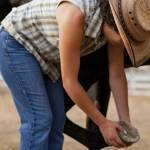Treatment Options for Leg Injuries in Horses

Years ago, a severely strained or ruptured tendon often signaled the end of a horse’s useful life. Treatment consisted of cold hosing or icing the injured leg and then months of stall rest, typically followed by more months of turnout. Few horses returned to their previous level of performance, and many were never reliably sound for even light work.
Subjected to stress every time the horse moves, the tendons and ligaments of the lower legs can be damaged by a sudden load or by the repeated demands of running, jumping, sliding, and turning. Years of everyday wear may bring on a series of minor injuries that make these connective tissues more subject to tearing because of an off-balance step or a sudden halt. Healing is complicated by adhesions and scar tissue that is not as elastic as the original fibers. Tendon and ligament injuries are still regarded as serious, but new treatment and management options are allowing horses to recover more fully than they did 50 years ago.
Ultrasound images are frequently used to diagnose the type and extent of an injury, and treatment is based on what is determined. In the first days after an injury, cold therapy can still be used, along with medications to control pain and reduce inflammation. One technique to help reduce inflammation is known as tendon splitting. In this treatment, a veterinarian inserts a very thin knife into the injured area and moves it up and down. This technique allows blood cells and clotting proteins to flow out of the injured tissues rather than forming a hematoma and adding to the inflammatory response. The localized damage created during tendon splitting may also stimulate further healing.
Ultrasound is also useful to monitor the recovery process, track the reduction in size of the original injury, and see how well the healing fibers are aligning with the old tissue. Changes can be made in treatment and exercise based on what is seen in the scans.
In the early stages of healing, a veterinarian can collect some of the horse’s own blood, spin it in a centrifuge to concentrate the platelets, and inject this platelet-rich plasma (PRP) back into the injured area. The platelets contain growth factors that aid healing, and no adverse reaction is triggered because the injected material came from the horse that is being treated. Platelet-rich plasma also provides a protein matrix that encourages new cells to generate in the correct form and alignment.
In another treatment, bone marrow is removed from the horse’s sternum or pelvis. The marrow is centrifuged and the resulting concentrated material, which contains growth factors and stem cells, is injected into the tendon or ligament. This procedure can be done in a barn where the horse lives, and is completed in a few hours compared to culturing stem cells, which takes days or weeks in a lab.
Both of these treatments, which are sometimes used together, tend to result in healed cells that are quite similar to original uninjured tissue rather than scar tissue. Another treatment that leads to proper tissue alignment and reduces stiffness is an exercise program that is begun as soon as possible after the initial injury. Rather than months of inactivity in a stall, injured horses usually begin limited exercise such as hand-walking (with appropriate mild sedation if necessary) within a few days. The specific exercise program is tailored to each horse’s progress and temperament.
Full healing of tendon and ligament injuries still takes a long time (up to a year in many cases) and can’t be rushed, but the prognosis is better than in years past due to better diagnosis, treatment, monitoring, and exercise plans.








